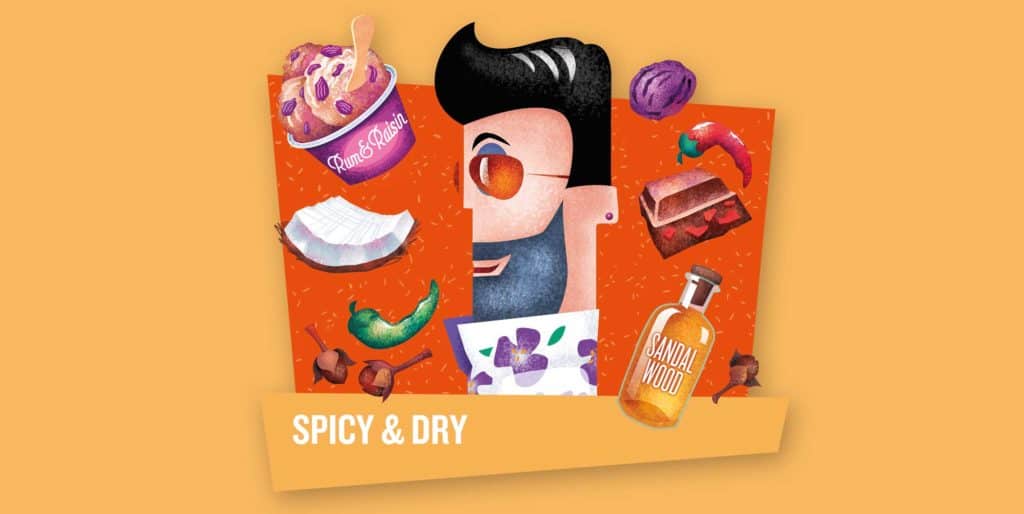WHERE FLAVOUR COMES ALIVE
With many of us having been on holiday or summering somewhere nice, it’s an ideal time to journey into the realm of flavours. As Julien Willems explains, Spicy & Dry flavour profile drams provide the perfect form of sensory escapism.
Summer holidays can be impromptu but are most often planned, securing passage to the dreamiest and most desirable places. During winter (or even the summer months if you live in Scotland…) many dream of warmth and summery flavours, and that’s something that Spicy & Dry tipples have in generous measure.
With a cascade of woody and exotically spicy notes, this profile forms a river of delicious treats that won’t soon run dry, with different aromatic streams merging to form unique and unexpected experiences.
The well-spring of it all is naturally the spirit, which can account for flavours like rum and raisin, as both elements are equally rich in esters. As we know, esters are flavour active compounds in whisky that are often associated with fruity flavours. They originate from the fermentation of malt by yeast during whisky production.
As with other flavour profiles, they can be plentiful or characteristically associated with a glut of aromas from citrus and apple to mango and pineapple. And they are here for sure: without any exception, all distilleries which have had one of their casks land in the Spicy & Dry profile have also landed in other, fruitier profiles. So, to get to the bottom of this flavour conundrum, we will have to jump ship and see where the good old wooden whisky vessels take us.
COMPOUND EFFECT
Our first stop on our cruise down the river is the spicy influence (think clove, sandalwood, nutmeg) in Spicy & Dry whiskies.
The likely carrier of these flavours is indeed the cask. As discussed for the Spicy & Sweet flavour profile, spiciness in whisky is a bit of a catch-all term that can regroup the effects of both alcoholic strength and those of various flavour-active compounds.
Among the latter, a few are also well known for their link to spicy aromas. Eugenol is commonly associated with flavours of cloves and clove oil, whereas guaiacol is generally said to have broader spicy and smoky characteristics. These compounds are derived from lignin, the main component of wood.
When a cask is heat-treated, lignin breaks down into vanillin, and other compounds like eugenol and guaiacol in different relative concentrations, depending on how the oak was heat-treated. The resulting interplay with other flavours can create a spectrum of aromas we perceive as spicy, taking our senses further down the sensory river, to exotic and sun-soaked latitudes.
TALKING TANNINS
Further downstream, we come across a forest and disembark to investigate. Imagine leaning against a tree on a hot summer’s day, taking a breath, immersed in your surroundings.
Something may smell familiar – tree bark, perhaps? Such aromas are often associated with a particular mouthfeel described as the gum-drying, gently chalky or powdery, typically associated with tannins. Tannins are present in every oak species, but their concentration varies widely from species to species, forest to forest and even from tree to tree in the same patch of woodland.
So even if your whisky was matured in a trusty Quercus alba American oak bourbon cask, which we have previously associated with sweeter, coconut and vanilla flavours, it is entirely possible that the result could be a spicier, drier whisky, depending on the cask make up.
COOPERAGE CONTROL
With this last point in mind, we journey onwards, to a cooperage in a clearing. Looking through the records of casks bottled by the Society since 2014, a vast majority of Spicy & Dry whiskies from some distilleries (including 13, 41, 44 and 77) have come from bourbon casks (from first fill to refill in relatively equal proportions).
We previously explained that cooperages have a great deal of control in selecting the right staves and heat-treatment levels to produce casks leaning more towards certain flavours. This is interesting, as Scotch whisky distillers often have deals in place to buy freshly emptied bourbon casks from partner bourbon distilleries.
Easy then to imagine how there might be a connection between a bourbon distiller’s coopering choices and the higher propensity of some whisky makes to see their bourbon cask-matured whiskies take on the Spicy & Dry aromatic mantle…
SPICE AND SUNSHINE
But leaving behind these considerations, we make our way back to the river and let ourselves be carried downstream to a secluded villa with a well-stocked bar.
Overall, whiskies of this profile have hailed from a variety of casks formerly used to mature bourbon, sherry, wines both dry and sweet or fortified, or even IPA and rum. They say variety is the spice of life, and this profile certainly brings water to that particular mill. Multi-faceted and difficult to encompass, Spicy & Dry will nevertheless take you on journeys to realms of spice and sunshine.
So, if you are yet to take your summer holiday, or if winter blues is hitting you hard (for our members and friends in the southern hemisphere), indulge in a bit of flavour escapism with spicy dishes from faraway lands and a matching dram to let your senses travel to where your heart yearns to be.

